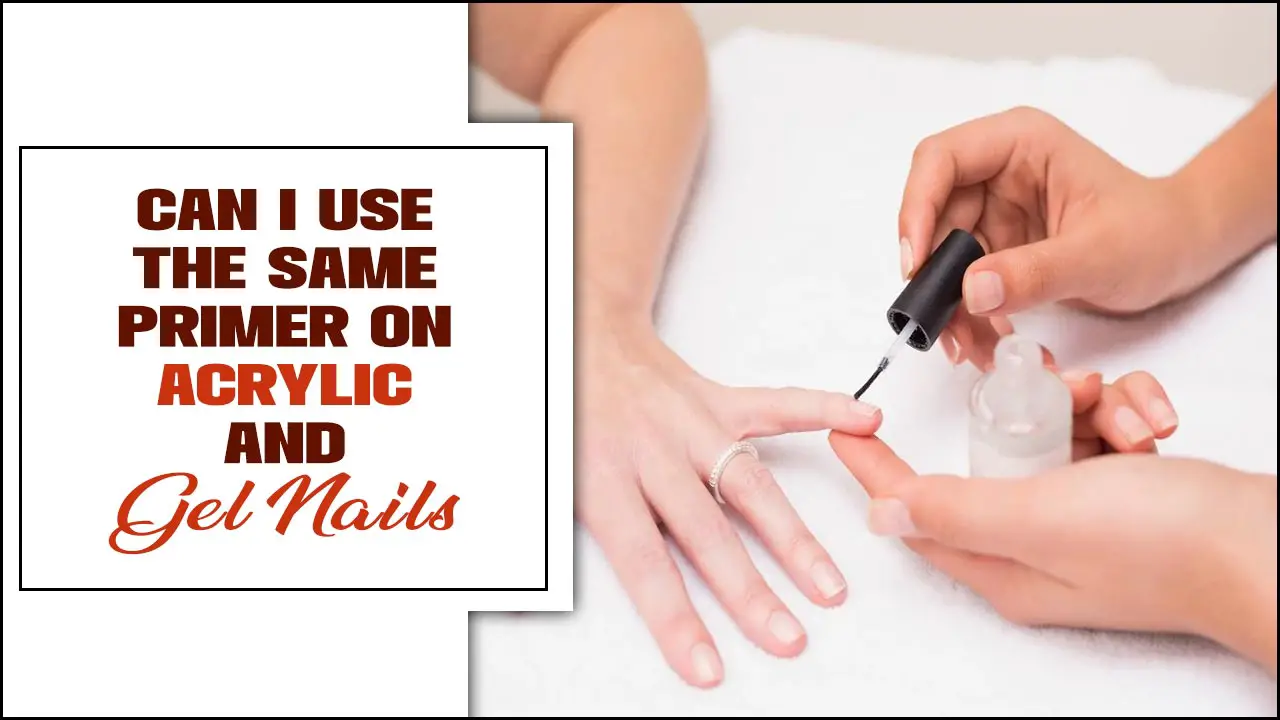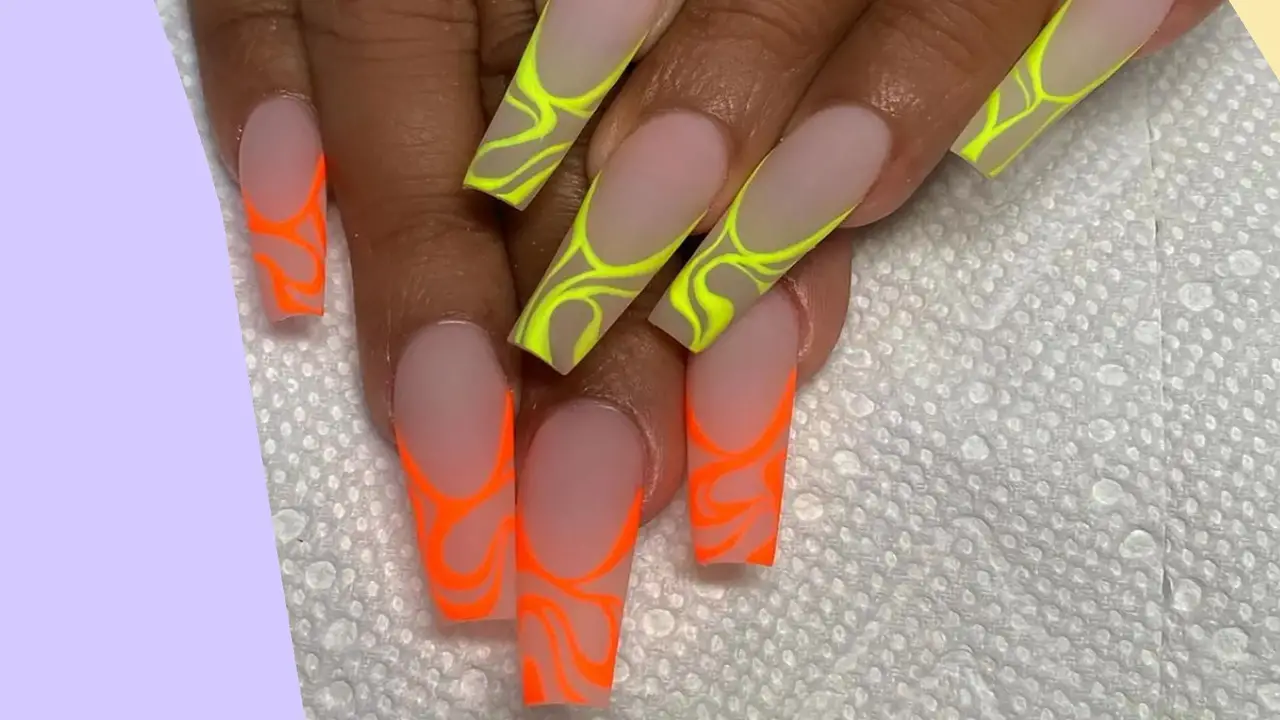Having perfectly manicured nails has become a staple in today’s beauty standards. With the rise in popularity of acrylic and gel nails, many people wonder if they can use the same primer for both nail enhancements.
While acrylic and gel nails offer long-lasting and durable results, they have different application processes and materials. One of the key components in achieving a successful and lasting manicure is the use of a primer. This product binds the natural nail and the artificial material, ensuring the enhancements stay in place.
However, with so many options on the market, it can be unclear whether the same primer can be handy for acrylic and gel nails. Here, we will dive into the world of primers and explore whether can i use the same primer on acrylic and gel nails.

Can I Use The Same Primer On Acrylic And Gel Nails -Answered

A primer for acrylic nails and a primer for gel nails serve different purposes and have different chemical compositions. A primer for acrylic nails typically contains acid that etches and dries out the nail’s surface to create a base for adhesion. On the other hand, a primer for gel nails tends to be chemical in nature, creating an attractive surface for the gel to adhere to.
Therefore, it is not recommended to use the same primer for both acrylic and gel nails as they are designed specifically for their respective applications. Using the wrong primer can compromise the adhesion and durability of the nail enhancements. It’s important to use the appropriate primer for each type of nail enhancement to ensure optimal results and longevity.
Choosing The Right Primer For Acrylic Nails
Choosing the right primer for acrylic nails is crucial for achieving strong and long-lasting nail enhancement. While some primers can be handy for acrylic and gel nails, it is important to understand the differences and how they may affect the choice of primer.
A primer is a crucial step in the application process as it helps to create a strong bond between the natural nail and the acrylic product. When selecting a primer for acrylic nails, it is essential to look for one that is specifically designed for use with acrylics. These primers are formulated to promote adhesion and prevent lifting or peeling of the acrylic nails.
It is not recommended to use a primer that is intended for gel nails on acrylics, as the formulations may differ and could potentially compromise the durability and longevity of the manicure. By choosing the right primer for your acrylic nails, you can ensure a beautiful and long-lasting result.
Choosing The Right Primer For Gel Nails

It is important to choose the right primer to ensure optimal adhesion and longevity of the manicure. While some may wonder if they can use the same primer for acrylic and gel nails, experts generally recommend using a primer specifically designed for gel nails. Gel nail primers are formulated with ingredients compatible with gel polish and gel extensions, providing a strong bond and preventing lifting or chipping.
Using a gel primer on acrylic nails may not provide the same level of adhesion and could compromise the durability of the manicure. To achieve the best results, it is always advisable to follow the manufacturer’s instructions and use the appropriate primer for each type of nail enhancement.
Risks And Consequences Of Using The Wrong Primer
An appropriate primer is crucial in various industrial applications, as it serves as a foundation for the subsequent layers of coatings, paints, or adhesives. However, we should not overlook the risks and consequences of using the wrong primer.
Primers have specific designs to promote adhesion between the substrate and the coating, ensuring long-term durability and performance. Risks and consequences of using the wrong primer on acrylic and gel nails. Using the wrong primer on acrylic and gel nails can have several risks and consequences. Here are some potential issues you may encounter:
- Poor adhesion: Primers are designed to create a strong bond between the nail and the applied product. Using the wrong primer can result in poor adhesion, causing the product to lift or peel off.
- Nail damage: Certain primers contain harsh chemicals that can damage the natural nail. Using the wrong primer may lead to nail dehydration, weakness, or breakage.
- Allergic reactions: Some individuals may have allergies or sensitivities to certain primer ingredients. Using the wrong primer can trigger allergic reactions, such as redness, itching, swelling, or dermatitis.
- Incompatibility with the product: Different primers are formulated to work with specific nail enhancements, such as acrylic or gel.
Proper Application Techniques For Acrylic Nails

Acrylic nails have become a popular fashion trend in recent years, with many individuals seeking to enhance the appearance of their hands. However, it is crucial to understand the proper application techniques for acrylic nails to achieve optimal results.
Applying acrylic nails is a delicate process that requires precision, skill, and attention to detail. Proper application techniques for acrylic nails involve the following steps:
- Prepare the natural nails: Clean the nails thoroughly and push back the cuticles. Remove any existing polish or oils from the nails using acetone or a nail polish remover.
- Choose the right tips: Select acrylic nail tips that fit the natural nails properly. Trim and shape the tips according to the desired length and style.
- Apply the primer: Before applying the acrylic, it is important to apply a primer to the natural nails. The primer helps the acrylic adhere better and prevents lifting. Use a brush or a cotton swab to apply a thin primer layer to the entire nail surface. Be careful not to get the primer on the skin or cuticles.
- Mix the acrylic: Mix a liquid monomer with a powdered polymer to create acrylic nails. Follow the manufacturer’s instructions to mix the acrylic properly. It should have a creamy consistency that is not too runny or thick.
Tips For Applying Primer Correctly
Primer is the foundation for any paint job, creating a smooth and even surface that allows the paint to adhere properly and provides a base for colour accuracy. Understanding the importance of applying primer correctly is crucial in achieving professional results.
Applying primer correctly is important when working with both acrylic and gel nails. Primer is a key step in the nail application process as it helps to improve adhesion and extend the longevity of the nail enhancements. To apply primer correctly, follow these steps:
- Ensure the nails are properly prepped by removing any old polish, buffing the surface, and shaping them to the desired length and shape.
- Use a gentle nail cleanser or rubbing alcohol to clean the nails and remove any oils or debris. This will help the primer adhere better to the nail plate.
- Dip a brush into the primer bottle and wipe off any excess product on the rim. Gently brush a thin primer layer onto the nail plate, avoiding the cuticles and skin. Be careful not to flood the nail with primer, which can cause lifting or other issues.
- Allow the primer to air dry completely. It usually takes a few seconds for the primer to dry, but the drying time may vary depending on the brand and formulation.
- Once the primer is dry, apply your acrylic or gel nails as usual. The primer will help create a strong bond between the nail plate and the enhancements, ensuring they stay in place longer.
Proper Application Techniques For Gel Nails

Proper application techniques for gel nails have become a significant topic of interest in manicuring and nail care. Gel nails, also known as gel polish, have gained popularity due to their long-lasting and durable nature and the glossy finish they provide.
However, to achieve optimal results and ensure the longevity of gel nails, it is essential to employ proper application techniques. Proper application techniques for gel nails:
- Prep your nails: Start by removing any existing nail polish and shaping your nails to your desired length and shape. Gently push back your cuticles using a cuticle pusher.
- Lightly buff your nails: Use a buffer to buff the surface of your nails lightly. This will create a rough texture that helps the gel adhere better.
- Apply a base coat: Apply a thin layer of gel base coat to your nails, covering the entire nail surface. Be careful not to get any on your cuticles or skin. Cure the base coat under a UV or LED lamp according to the manufacturer’s instructions.
- Apply the gel colour: Apply a thin layer of gel colour to your nails, again making sure to cover the entire nail surface. You can apply multiple thin coats for a more opaque colour, curing each coat under the lamp.
Conclusion
While using the same primer for acrylic and gel nails may be tempting, it is important to remember that these nail enhancements have different chemical compositions and require specific primers to ensure proper adhesion and longevity.
By understanding the differences between acrylic and gel nails and using the appropriate primer for each, you can achieve beautiful and long-lasting results for your clients. It is always best to consult with a trained and licensed nail technician for the best recommendations and techniques for using primers on different types of nails. We hope you understand above mentioned topic “can i use the same primer on acrylic and gel nails”.
FAQs
1.What Is The Difference Between Acrylic And Gel Nails?
Ans: Acrylic nails combine a liquid monomer with a powder polymer to create a thick paste. Gel nails, on the other hand, are made by applying a gel polish to the natural nail or an extension tip and then curing it under a UV or LED lamp.
2.Are There Any Differences In The Application Process When Using The Same Primer On Acrylic And Gel Nails?
Ans: Yes, there are differences in the application process when using the same primer on acrylic and gel nails. It would be best to use a liquid monomer and a polymer powder for acrylic nails while applying gel nails using a gel product cured under a UV or LED lamp.
3.Will You Use The Same Primer On Acrylic?
Ans: You can use the same primer on acrylic and gel nails. Primer is an essential step in nail preparation, as it helps create a strong bond between the natural nail and the artificial extensions. Whether applying acrylic or gel nails, using a primer is crucial to ensure longevity and prevent lifting or peeling of the enhancements.
4.Are There Any Specific Primers That Are Recommended For Use On Both Acrylic And Gel Nails?
Ans: Yes, primers are available specifically formulated to be handy on acrylic and gel nails. These primers usually contain ingredients that promote adhesion to both nail materials, allowing for a strong and long-lasting bond. It is important to choose a high-quality primer compatible with acrylic and gel systems to ensure optimal results and minimize the risk of lifting or damage to the nails.
5.What Are The Potential Risks Or Drawbacks Of Using The Same Primer On Acrylic And Gel Nails?
Ans: Using the same primer on acrylic and gel nails can lead to potential risks or drawbacks. The primer formulation may not be suitable for both nail enhancements, resulting in poor adhesion or improper curing. This can lead to lifting, peeling, or premature nail chipping.




